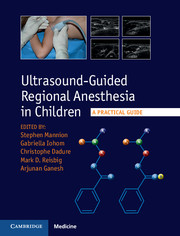Book contents
- Frontmatter
- Contents
- List of contributors
- 1 Introduction
- Section 1 Principles and practice
- 2 Performance of regional anesthesia in children
- 3 Pharmacology of local anesthetics in children
- 4 Management of complications of regional anesthesia
- 5 Basics of ultrasonography for regional anesthesia in children
- 6 Anatomy of the neuraxis, thoracic and abdominal walls, upper and lower limbs
- Section 2 Upper limb
- Section 3 Lower limb
- Section 4 Truncal blocks
- Section 5 Neuraxial blocks
- Section 6 Facial blocks
- Appendix: Muscle innervation, origin, insertion, and action
- Index
- References
4 - Management of complications of regional anesthesia
from Section 1 - Principles and practice
Published online by Cambridge University Press: 05 September 2015
- Frontmatter
- Contents
- List of contributors
- 1 Introduction
- Section 1 Principles and practice
- 2 Performance of regional anesthesia in children
- 3 Pharmacology of local anesthetics in children
- 4 Management of complications of regional anesthesia
- 5 Basics of ultrasonography for regional anesthesia in children
- 6 Anatomy of the neuraxis, thoracic and abdominal walls, upper and lower limbs
- Section 2 Upper limb
- Section 3 Lower limb
- Section 4 Truncal blocks
- Section 5 Neuraxial blocks
- Section 6 Facial blocks
- Appendix: Muscle innervation, origin, insertion, and action
- Index
- References
Summary
Introduction
Regional anesthesia in children is safe. Serious complications such as nerve injury, systemic toxicity, serious infections, and visceral or dural punctures are very rare.
Complications following regional anesthesia can be minimized through good clinical practice, and there is increasing evidence that ultrasonography may play an increasing role in further enhancing safety (Griffin and Nicholls, 2010).
Recently three large databases have provided prospective data on the complications of regional anesthesia in children. The Pediatric Regional Anesthesia Network (PRAN) study (Polaner et al., 2012), the French-Language Society of Pediatric Anesthesiologists (ADARPEF) survey (Ecoffey et al., 2010), and the National Paediatric Epidural Audit (NPEA) from the UK and Ireland (Llewellyn and Moriarty, 2007), together have reported on the complication rates relating to 56 682 regional anesthetic procedures in children.
Overall the reported risk of serious complications in these studies has been shown to be very low. Notably there were no deaths from regional anesthesia reported in any of these studies. There was only 1 case of morbidity with effects lasting greater than 1 year. This case was reported in the NPEA and involved a 4-month-old child, who had a partial neurologic deficit still present 1 year after an epidural drug error. The incidence of serious complications in the French and American databases ranged from 0.12 to 0.15%. In all these cases, resolution of the complication occurred by the studies' follow-up times of 3 months (PRAN) or 1 year (ADARPEF).
These data are reassuring as regards the safety profile of regional anesthesia in children; however, they should not lead to complacency as the risk is never zero (Boretsky, 2014).
This chapter will discuss the types of major complications after regional anesthesia in children and describe the management of each of these.
Local anesthetic systemic toxicity
In children, local anesthetic systemic toxicity (LAST) following regional anesthesia is an extremely rare but potentially life-threatening condition. The risk of developing LAST is estimated to be 0 to 2:10 000 from prospective databases (PRAN/ADARPEF/NPEA). This is similar to the risk of LAST in adults, which was recently estimated to be 0.37:10 000 (Ecoffey et al., 2014).
- Type
- Chapter
- Information
- Ultrasound-Guided Regional Anesthesia in ChildrenA Practical Guide, pp. 20 - 29Publisher: Cambridge University PressPrint publication year: 2015



